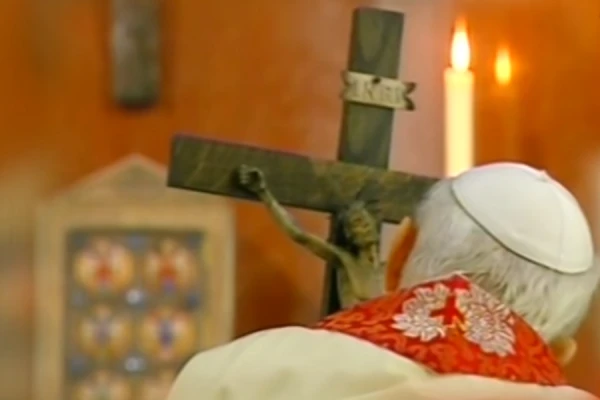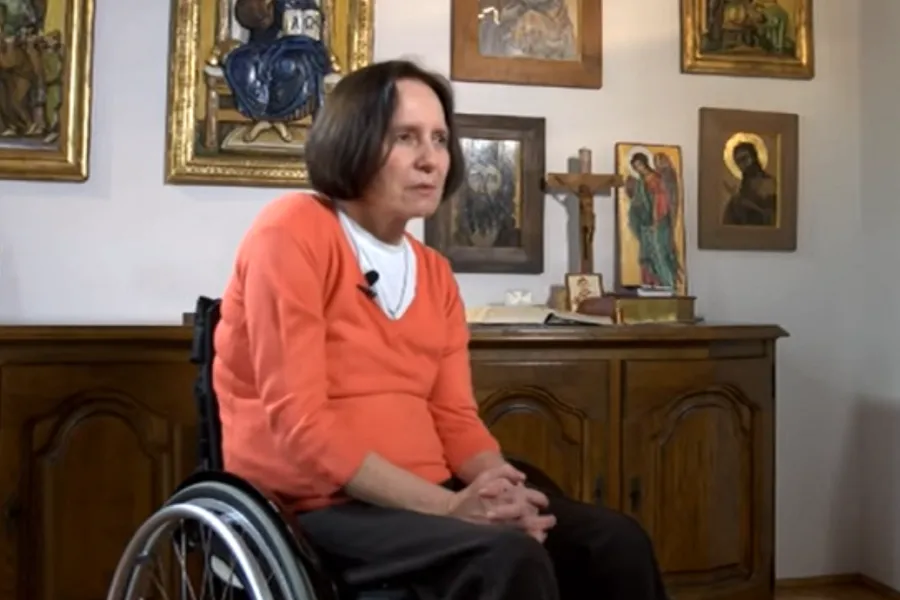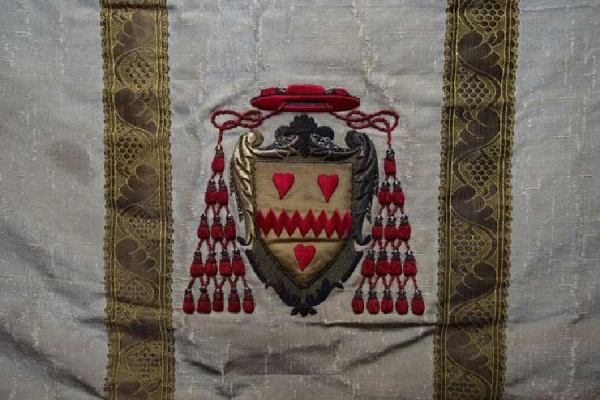
CNA Staff, Apr 2, 2021 / 05:00 am (CNA).- Days before Pope John Paul II’s death on April 2, 2005, Vatican television cameras captured extraordinary footage of the Polish pope.
He was sitting alone facing the altar of his private chapel. Beneath the crucifix and tabernacle was a television screen showing a torchlit procession at Rome’s Colosseum.
It was Good Friday and the 84-year-old pope was unable to lead that year’s Way of the Cross because of his infirmity. But he was still determined to take part.
Images of the pope in his chapel were broadcast live on video screens at the Colosseum. The thousands present there cheered as they saw him sitting silently with his back to the camera.
Near the end of the Via Crucis, John Paul II was seen holding a large wooden crucifix.
The crucifix originally belonged to a Polish woman called Janina Trafalska, who like the pope experienced great suffering.
Janina told her story to the Polish Catholic television station TV Trwam in a documentary entitled “The Holy Cross, Above All.”
In 1990, at the age of 29, she plunged from a window, damaging her spine. As she underwent months of medical treatment, her artist husband, Stanisław, spent time in the Bieszczady Mountains in southeast Poland, praying for his wife as he completed the Stations of the Cross.
After Janina finished her therapy, she fell into despair. She wondered why God had permitted an accident that shattered her life’s dreams. Confined to a wheelchair, she began to withdraw from those around her.

In 1996, Stanisław carved two crosses. He gave one to his wife and the other to a priest in Rzeszów, a city near the village of Stefkowa where the couple lived.
In the year 2000, the head of the local municipality was invited to the Vatican. He asked Stanisław for a gift he could present to the pope. Janina decided to donate her crucifix.
After the delegation presented the cross to John Paul II, he entrusted it to his secretary, Fr. Mieczysław Mokrzycki.
On Good Friday 2005, as pilgrims reached the 14th Station of the Cross at the Colosseum, John Paul II asked for a cross. Mokrzycki went to his room and brought back Janina’s crucifix for the pope to venerate.
When the images of John Paul II were broadcast worldwide, the Trafalski family recognized their crucifix. Janina later said that she felt unworthy of the honor, remembering her earlier rebellion against suffering.
The Polish pope died days later. In 2007, Mokrzycki was appointed coadjutor archbishop of Lviv in Ukraine. He took the crucifix with him from Rome.
According to the Polish Catholic website niedziela.pl, he gave it to his parents, who in turn presented it to Fr. Mieczysław Bizior, who installed it in his church in the village of Kraczkowa in southeastern Poland.
The crucifix is taken around neighboring parishes. Wherever it goes, it helps to inspire an intense atmosphere of prayer.
While John Paul II did not address the crowds on Good Friday 2005, he sent a brief message that was read out by Cardinal Camillo Ruini, vicar general of Rome diocese.
The pope said: “I am with you in spirit at the Colosseum, a place that stirs up within me so many memories and emotions, in order to take part in the evocative rite of the Way of the Cross on this Good Friday evening.”
“I join you in the invocation, so rich in meaning: ‘Adoramus te, Christe, et benedicimus tibi, quia per sanctam crucem tuam redemisti mundum.’ Yes, we adore and bless the mystery of the Cross of the Son of God, because it was from his death that new hope for humanity was born.”
“The adoration of the Cross directs us to a commitment that we cannot shirk: the mission that St Paul expressed in these words: ‘[I]n my flesh I complete what is lacking in Christ’s afflictions for the sake of his body, that is, the Church’ (Col 1: 24).”
“I also offer my sufferings so that God’s plan may be completed and his Word spread among the peoples. I, in turn, am close to all who are tried by suffering at this time. I pray for each one of them.”
He concluded: “On this memorable day of Christ’s crucifixion, I look at the Cross with you in adoration, repeating the words of the liturgy: ‘O crux, ave spes unica!’ Hail, O Cross, our only hope, give us patience and courage and obtain peace for the world!”
If you value the news and views Catholic World Report provides, please consider donating to support our efforts. Your contribution will help us continue to make CWR available to all readers worldwide for free, without a subscription. Thank you for your generosity!
Click here for more information on donating to CWR. Click here to sign up for our newsletter.




Suffering whether emotional or physical purifies our will. Humiliation and shame are forms of emotional pain endured best by the spiritually strong. They know who they are. Physical pain challenges our endurance to persist. Dr Leroy Huizenga in his article The Violence of the Crucifixion alludes to the emotional shame Christ suffered as exceeding the physical. It’s a feasible perception. Now what was the driving force that made Christ endure excruciating physical pain if not his love for us? Similarly with the shame of the Cross. For the Lord of the Universe infinitely good deserving all our love to endure the outrage of insult, hatred, utter contempt and humiliation required heroic virtue, virtue perfected as Aquinas says upon the Cross. Cardinal Dizwisz notes in his article John Paul II bore his extreme infirmity and I may add disfigured appearance quite well, almost as a badge of courage as I perceived him in Rome. Whether endurance of physical or emotional pain differs I’m convinced either is won by love. That the contempt of that love was the cause of greatest suffering for God who is love. Now to the centurion who said, Surely this was the Son of God. Dr Huizenga perceives this as a contemptuous remark, a reasoned opinion by a scholar deserving consideration, whereas Mark and Matthew apparently paint a different picture. Mark, “When the Roman officer who stood facing him saw how he had died, he exclaimed, This man truly was the Son of God!” He witnessed a man who forgave the repentant thief, forgave his torturers, called out to God at the moment of death. No pleading for mercy, no anger. All the virtues perfected in a man as Man is called to be. That, I submit the recognition of the divinity in Christ’s manner of suffering indicated by the Roman centurion’s response reveals the saving power of the Cross begin its work of redemption for the gentile world. In like manner I’m convinced John Paul II was well aware of his heart rendering, even salvific example for priest and layman addressed by Dziwisz evident in his persistence in suffering the shame and physical pain of the Cross of Christ.